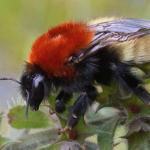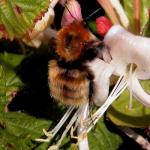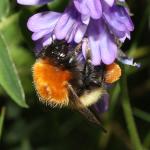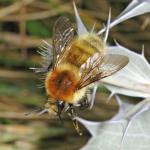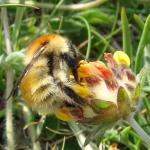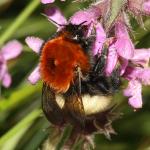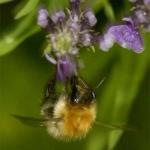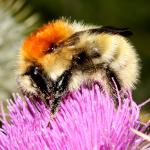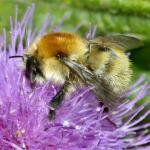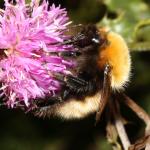Bombus pallidus EVANS 1901not of CRESSON 1863 (= B. pensylvanicus (DEGEER)); Bombus laevis VOGT 1909; ?nigripes PEREZ 1909 nec. HALIDAY in Curtis et al., 1837:321 (= B. dahlbomii GUERIN-MENEVILLE); Bombus ?pereziellus (SKORIKOV [1923]; Bombus ?bannitus (SKORIKOV in POPOV 1930); ?Bombus liepetterseni LOKEN 1973; Bombus celticus YARROW 1978; Bombus agricolae BAKER 1996
From Williams http://www.nhm.ac.uk/research-curation/research/projects/bombus/th.html#muscorumOne of four brown bumblebees known from the British Isles; two of which, B. muscorum and B. humilis, are declining greatly and were included in research undertaken by the Bumblebee Working Group. The biology of these two species is very similar. Both are associated with extensive areas of tall, but open, flower-rich grasslands, especially those which have many flowers with long corollae, such as clovers, dead-nettles and yellow-rattle. B. muscorum is the more northerly distributed species and tends to occupy damper habitats in the south of the British Isles: however, both species fly together in several areas. Identification is very difficult in the field. In females this relies, in the main, on the presence (B. humilis) or absence (B. muscorum) of black hairs on the thorax in most specimens, although this distinction is not complete. Under a microscope, the form of the pits from which certain of the tergal hairs arise is the best character. The form of the male genitalia is diagnostic but requires microscopic examination. Both species are readily confused with specimens of the much more common B. pascuorum where the black hairs on the side of the abdomen are very reduced. This is a particular problem towards the north. There are a number of distinct forms associated with some of the larger off-shore islands.
Widely distributed throughout Britain and Ireland, but showing signs of continuing severe decline since 1970. Note that this will not show in the post-1970 date class of the published map. Now largely coastal with particularly strong populations associated with some of the larger off-shore islands.
Although not noted as being of conservation significance in Falk (1991) it is likely that its status is in need of revision.
Associated with large areas of open, flower-rich grassland, although it may also be found on flower-rich areas within extensive moorland in Scotland.
The species is eusocial, with queens emerging from hibernation in May, workers present from June onwards and males and new females from July to early September.
Nests are made above-ground in tall, but open grassland. It is one of the carder-bumblebees, which gather moss and dry grass to make the covering of the nest. Nest sizes are small, with between 40 and 120 workers (Løken 1973, von Hagens 1994). The life of the nest is short, about 3 months.
Strongly associated with flowers with longer corollae, especially Fabaceae, Scrophulariacae, Lamiaceae and red-flowered Asteraceae.
This species may be attacked by the socially parasitic species Bombus campestris, but this requires confirmation.
Profile written:
Proofed: March 2012


